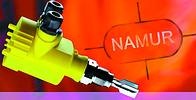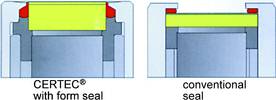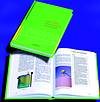

Vega Instruments has developed a number of top quality sensors suitable for use in the most demanding of modern processing plants. This article briefly discusses two of these instruments, and introduces a valuable book on radar level measurement that is currently available from Vega Instruments South Africa.
Pressure measurement technology in hygienic and sterile environments
Pressure transmitters for the food and pharmaceutical industry must meet the most demanding hygienic and aseptic requirements.
In spite of the differences in the production and processing of foodstuffs and in the preparation of pharmaceuticals, these processes have basic things in common with regard to hygiene and sterilisation.
Milk, beer and juices on the one hand and medicines and vaccines on the other require vastly different processing methods but they must all ensure that the product is not damaged and that its original properties are retained.
The hygienic concept determines not only the microbial content of the product but also its biological quality. The layout of the production facility must therefore guarantee that microorganisms cannot propagate and that production and cleaning can be carried out reliably under reproducible conditions.
Pressure transmitters with perfectly flush mounting and high surface quality are of great importance in the food and pharmaceutical industry. However, they are not yet the standard. Commonly used are pressure transmitters, which, due to design constraints, have a measuring cell that is set back and therefore not completely flush.
Vega Instruments' D84 and D94 Certec pressure transmitters are special dry cell, ceramic-capacitive pressure transmitters for food and pharmaceutical applications, and are making an impact in this area. Thanks to their flush design, they behave as if they were a part of the polished vessel wall.
During the process of CIP cleaning, temperatures up to 80°C are common, and in SIP processes, hot steam up to 140°C is applied, giving rise to pressures of up to 250 kPa (2,5 bar). These instruments can withstand up to 80 times their working range as an over pressure rating.

Acids, caustic solutions and tensides (used to reduce surface tension and hold foreign matter in suspension) are also used in the cleaning process. It follows that pressure transmitters must be chemically resistant against a large number of different products, cleaning agents and disinfectants.
The ceramic diaphragm used in Vega's D84 and D94 pressure transmitters was developed to withstand the cleaning agents and the micro-erosion caused by liquids and pastes. The housing technology was also developed to eliminate condensation forming in the housing IP68 and guarantees safe use of the instruments in wet areas, and reliable operation under all process conditions.
Vibrating level switch with NAMUR interface
The new generation of Vega level switches are now equipped with very short, 40 mm, vibrating forks. In conjunction with an optimisation of the electronics and the piezo drive, this smaller design enables a reliable transmission of the switching signal, with far less power than that required by previous technology.
As a result, it is possible to use electrical interfaces, such as the NAMUR interface, that operate with minimal power requirements. This internationally standardised interface (IEC 60947-5-6), more commonly known as DIN 19234, is now being used in many areas of automation. Originally developed specifically for application in explosion-endangered areas (Zone 0), this technology has gained an increasing foothold in areas of factory automation. The current-based signal is fail-safe and well tested. Nearly all suppliers of switching amplifiers offer a variety of devices or input cards that have a NAMUR interface leading to the sensor or to the process. NAMUR modules exist which allow interfacing to field technologies (such as Profibus) for switching functionality.
With a vibrating fork only 40 mm long and a robust, screwed-in piezo drive unit, these vibrating level switches cover a wide range of applications, handling product temperatures up to 250°C and pressures of up to 6,4 MPa (64 bar). Because of the previously used, conventional piezo technology, limit levels in ambient temperatures over 150°C and pressures over 40 bar could not be detected with this measuring principle.
To guarantee reliable detection even at higher temperatures, it is absolutely necessary to screw in the piezo drive unit as opposed to using adhesives. This type of drive mounting has advantages not only for higher temperatures, but also provides temperature shock resistance over the whole application range of -50 to +250°C.
"This is the outstanding feature of this universal limit level switch", says Alan Wynn, MD of Vega Instruments SA, "Due to this, the sensor is suitable for any liquid that may be pumped. Needing no maintenance or calibration and being unaffected by turbulence, heavy flow, bubbles or foam, the device can even be applied in situations where extreme build-up occurs", he continues. Vegaswing 60 also operates independently of the electrical properties of the medium.
Approvals such as WHG, Atex, FM and ship approvals, as well as a wide array of process connections, coatings, and special materials are also offered with the NAMUR interface. The 40 mm long fork now makes it possible to reliably detect liquids in pipelines down to size DN 25.
The secrets of radar
A definitive new book on radar level measurement technology for measurement and control engineers is available from Vega Instruments South Africa.
This book, under the title 'Radar Level Measurement - The User's Guide', describes the history and physics of radar technology and contains practical knowledge for industrial applications.

Radar level measurement sensors are used in a wide spectrum of applications in the industrial and process industries and engineers have a large selection of radar sensors for different process conditions.
A radar application on a rotary kiln in the cement industry has very different requirements from a radar application on sterile vessels in the pharmaceutical industry or lacquer storage tanks in the automobile industry. The technical concept of a plant and the optimum sensor selection requires comprehensive specialist know-how on the part of the engineer. Vega, also a leading manufacturer of radar sensors, has published this book with detailed and illustrated descriptions of radar sensors to assist engineers in their choices.
Vega Instruments
(011) 958 1901
| Tel: | +27 11 795 3249 |
| Email: | [email protected] |
| www: | www.vega.com/en/home_za |
| Articles: | More information and articles about VEGA Controls SA |

© Technews Publishing (Pty) Ltd | All Rights Reserved